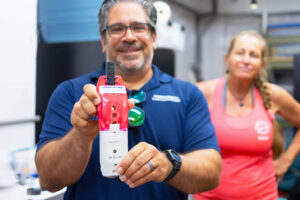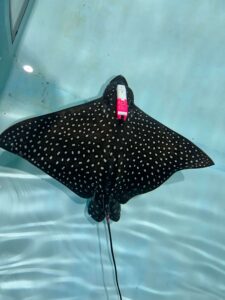At Mote Marine Laboratory in Sarasota, Florida, researchers use specialized suction cup mounted “helmet” tags to collect acoustic and movement data on whitespotted eagle rays. These tags will help examine the relationship between eagle rays and their prey and can be leveraged to evaluate their interactions with shellfish aquaculture and restoration.
This new technology is part of a five-year project, which started in March 2022, funded by the National Science Foundation Faculty Early Career Development Program (NSF CAREER) to Dr. Matthew Ajemian at Florida Atlantic University’s Harbor Branch Oceanographic Institute (FAU-HBOI)* who is leading this research in partnership with Mote and Woods Hole Oceanographic Institution (WHOI)**.
The team of researchers consists of Mote’s Sharks & Rays Conservation Research Program Senior Biologist Kim Bassos-Hull, FAU/HBOI Associate Research Professor and lead Principal Investigator Dr. Matthew Ajemian, and WHOI Associate Scientist T. Aran Mooney.
This 5-year CAREER project will apply recent technological developments in passive acoustics, including the “Helmet” tags, to better understand how and what whitespotted eagle rays and other large shellfish predators consume, and how that effects the overall health of the ecosystem.
“We’re finding that whitespotted eagle rays consume hard-shelled marine organisms that are ecologically and economically important animals that provide food resources to humans and marine life, maintain and improve coastal water quality, create habitat for a variety of species, and stabilize and protect sensitive shorelines,” said Bassos-Hull. “While these hard-shelled marine organisms are known prey for whitespotted eagle rays, they also experience other stressors including rising water temperatures and ocean acidification, leading to a major decline in shellfish populations. With this study, we’re looking at where and when whitespotted eagle rays and other predators prey on these organisms, with hopes of developing stronger capacity to mitigate the worldwide declines of shellfish populations.”
Bassos-Hull and Ajemian have also partnered with Sarasota Bay Watch, a local Sarasota Bay NGO doing clam restoration in areas of Sarasota and Manatee county coastal waters, to understand eagle ray interactions at these sites. These preliminary results will be presented at the International Conference on Fish Telemetry (ICFT) in Sete, France June 11-16 (https://icft2023.sciencesconf.org/).

In collaboration, the researcher team conducted trials in Mote’s Marine Experimental Research Facility (MERF) this spring using specialized CATS-CAM suction cup mounted tags, which resemble helmets, on eight whitespotted eagle rays. These new electronic, multisensor biologging tags record audio, video and fine scale movements including acceleration, postural movements when feeding on the bottom, and interactions with the seabed. Working in this facility and recording known predation events helps the researchers build training “libraries” of sounds so that they can develop AI-based algorithms to detect and classify these interactions from sensors deployed in the wild. It is hoped that these recordings will shed light on elusive interactions with natural shellfish communities and shellfish aquaculture and restoration areas.
Bassos-Hull began conducting her ray research at Mote in 2009 to better understand life history and behavior of whitespotted eagle rays, a widely under-researched species, to contribute to conservation and management.
“There was very little known about the whitespotted eagle rays at that time,” she said. “We are investigating what they eat, what it sounds like when they eat, and can use that as a tool for understanding what they’re feeding on and where they’re feeding in the environment. The eventual goal is to help us understand and mitigate predator activity around shellfish aquaculture and restoration activities.”
Fourteen years ago, Ajemian began collaborating with Bassos-Hull, sharing a mutual passion for understanding the species.

“We’re using the acoustics to learn what different types of prey crunching sounds like,” said Ajemian. “Does the ray feeding on clam sound different than a ray feeding on a conch? This is integrating tagging with computer science and engineering. The goal of this project is to give us a window into their world, to understand how they are affecting prey and seabed communities.”
The research project is supporting the graduate education of Ceclia Hampton, a graduate student supervised by Ajemian, and has been assisted by Ariadna Rojas Corzo, another Ph.D. who is leveraging the opportunity to work with rays in Mote’s MERF to test methods to mitigate predator effects on shellfish growout and restoration. Bassos-Hull and her team were also joined by Breanna DeGroot, Research Coordinator at FAU-HBOI.
All research is conducted under Mote’s FWC special activity license (SAL-1140) and reviewed IACUCs.
*FAU-HBOI is a research community of marine scientists, engineers, educators and other professionals focused on Ocean Science for a Better World founded in 1971. The institute drives innovation in ocean engineering, at-sea operations, drug discovery and biotechnology from the oceans, coastal ecology and conservation, marine mammal research and conservation, aquaculture, ocean observing systems and marine education
**WHOI is the world’s premier independent organization dedicated exclusively to ocean research, technology, and education. We combine state-of-the-art science, engineering, and ship operations to unravel the mysteries of the deep and devise science-based solutions to planet-wide problems.


